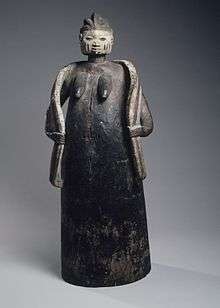Gẹlẹdẹ
.jpg)



The Gẹlẹdẹ spectacle of the Yoruba is a public display by colorful masks which combines art and ritual dance to amuse, educate and inspire worship.[1] Gelede celebrates “Mothers” (awon iya wa), a group that includes female ancestors and deities as well as the elderly women of the community, and the power and spiritual capacity these women have in society. However, this power may also be destructive and take the form of witchcraft; therefore, Gelede serves the function of appeasing this power, as well.[2]
Gelede in the context of Yoruba belief
The Gelede social agenda rests on the Yoruba maxim Eso l'aye (The world is fragile). In other words, life is delicate and should be lived with caution and with an emphasis on diplomacy, consideration, respect and harmony.[1]
The origins of Gelede
Most Yoruba myths of origin can be found in the divination narratives knows at Odu Ifa. There are approximately 256 Odu Ifa, each of which contains a number of poems called ese Ifa. A typical ese Ifa is a narrative about a person or animal with a problem and the steps to resolve that problem. An ese Ifa explains the origins of Gelede as beginning with Yemoja, "The Mother of all the orisa and all living things." Yemoja could not have children and consulted an Ifa oracle, who advised her to offer sacrifices and to dance with wooden images on her head and metal anklets on her feet. After performing this ritual, she became pregnant. Her first child was a boy, nicknamed "Efe" (the humorist); the Efe mask emphasizes song and jests because of the personality of its namesake. Yemoja's second child was a girl, nicknamed "Gelede" because she was obese like her mother. Also like her mother, Gelede loved dancing.
After getting married themselves, neither Gelede or Efe's partner could have children. The Ifa oracle suggested they try the same ritual that had worked for their mother. No sooner than Efe and Gelede performed these rituals- dancing with wooden images on their heads and metal anklets on their feet- they started having children. These rituals developed into the Gelede masked dance and was perpetuated by the descendants of Efe and Gelede.[1]
This narrative is one of many stories that explains the origin of Gelebe. An outdated theory states that the beginning of Gelede might be associated with the change from a matriarchal to a patriarchal society.[1]
Gelede spectacle
Although Gelede ceremony may be staged at any time of the year (to better the lot of an individual, to cleanse the society of pestilence, to induce rain, to enrich human fertility, to enlist the support of supernatural forces and the "powerful mothers" in wartime, and to honor the dead), the most elaborate performance occurs during the annual festival.
Once the exact dates of the festival are fixed, usually through divination, the Iyalase notifies the head of the community and the important chiefs. Messages then go out to all members of the Gelede society outside the town or working far away to return home for the celebration.
The festival begins with an all-night concert called efe, which features the Efe male mask, who uses satire to entertain and educate. Given the concern of the Gelede society with peace and social stability, it is not surprising that didactic themes recur in efe songs.
After the efe dance, most of the attendees spend the morning sleeping in preparation for the afternoon dance, which takes place in the marketplace and features pairs of male dancers who perform to fast-paced music with a vigorous beat.
The Gelede ceremony involves carefully choreographed dance, singing and music, and especially drumming. The performances are given by men, wearing masks that feature sculpted images of scenes including animals and people or sewing machines and drums. The pairs of men masquerade as women to amuse, please and placate the mothers who are considered very powerful, and who may use their powers for good or destructive purposes. These powers are especially linked to childbirth. The abilities they possess may be activated either consciously or unconsciously.[3]
Gelede costume and headdress
Gelede masks are worn with a costume consisting of layers of elaborate, colorful cloth.
The Gelede "mask" is more accurately a headdress, since it rests on top of the head and the wearer's face is covered by a cloth veil. The headdress takes the form of a human head, on top of which are motifs that are intended to entertain onlookers but, in addition, usually address social concerns that may also be expressed in songs that are part of the masquerade. The headdresses are usually brightly painted.[2]
Individuals or families will usually go to any length to make their headdresses as attractive and humorous as possible. The endless variety of the motifs and their combinations makes it difficult to attempt to construct a typology of Gelede headdresses.[1]
Most of the headdresses have facial adornments, ranging from lineage marks to decorative tattoos, which are either incised or painted.
Babatunde Lawal writes: "The headdress is to the costume what the head (ori) is to the human body. It is an index of identification and the essence of the masker's personality as long as he is inside the mask. In spite of the comical representations that often appear on the headdress, the face below the superstructure remains serene, as if stressing the paradox that is life-and the need to live life with special care."[1]
References
- 1 2 3 4 5 6 Lawal, Babatunde (1996). The Gèlèdé spectacle : art, gender, and social harmony in an African culture. Seattle: University of Washington press. ISBN 978-0-295-97599-3.
- 1 2 Siegmann, William C.; Adande, Joseph; Dumouchelle, Kevin D. (2009). African art a century at the Brooklyn Museum. Brooklyn, NY: Brooklyn Museum. ISBN 978-3791343211.
- ↑ Birmingham Museum of Art (2010). Birmingham Museum of Art: A Guide to the Collection. London: Giles. p. 71. ISBN 978-1-904832-77-5. Retrieved 2011-07-01.
